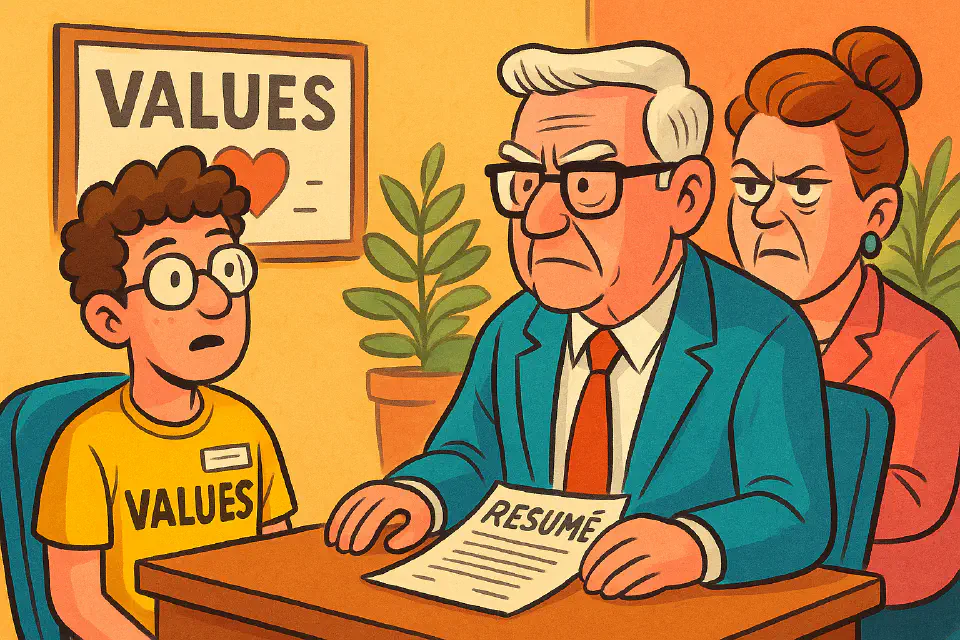
Are We Hiring for Values or Just Reinforcing Bias?
Hiring for values isn’t the problem. Assuming what those values look like based on age is. This guide shows how to balance integrity and inclusion when aligning organizational and personal values.
Hiring for values sounds noble. But are we unintentionally screening out people based on stereotypes?
A recent comment on LinkedIn sparked a heated debate: Could hiring for values actually perpetuate ageism? At first glance, it feels like a stretch. But when we dig deeper, this raises a powerful question about what we mean by “fit”—and who decides what values look like.
In this article, we explore the tension between organizational values and individual values, the risks of bias hidden in well-meaning hiring practices, and what HR can do to ensure alignment doesn’t become exclusion.
What Are Values, Really?
Let’s start at the root. Values are principles or beliefs that guide behavior. They’re often held up as anchors for both people and organizations.
But here’s the tricky part: values are often abstract. What one person sees as “respect,” another might interpret completely differently. And when organizations start screening for values in hiring, those interpretations matter.
Where Bias Creeps In
It’s easy to say, “We’re looking for someone who shares our values.” But what happens when those values get conflated with traits we associate—consciously or unconsciously—with a certain age, background, or personality?
Suddenly, values alignment becomes a proxy for sameness.
And sameness isn’t culture—it’s comfort.
Ageism and the Fit Trap
Ageism cuts both ways. Young professionals are told they lack experience or “don’t want to work.” Older professionals are viewed as “set in their ways” or unlikely to adapt.
When organizations overemphasize cultural fit—especially without defining it—it opens the door for assumptions based on age, not alignment.
That’s not inclusion. That’s filtering.
Values Without Action Are Just Wall Art
Many companies proudly display their values in reception areas and websites. Words like Integrity, Respect, and Innovation are everywhere.
But do these words match what candidates experience?
Can Values Be Age-Neutral?
Yes—if we treat them as principles, not proxies.
For instance, values like “integrity” or “collaboration” aren’t bound to age. But if your definition of collaboration involves Slack channels and memes, you might unconsciously exclude someone with different tools but the same intent.
Let’s stop assuming that values come in one generational flavor.
How to Hire for Values—Without Reinforcing Bias
So what does good values-based hiring look like?
1. Be Specific and Behavioral
Ask: What does “respect” look like in our context? Describe behaviors you want to see, not personalities you assume will bring them.
2. Diversify the Panel
The more perspectives on your interview panel, the less likely you are to rely on gut feel or assumptions.
3. Train for Awareness
Help hiring managers spot the difference between values alignment and comfort bias—and challenge them when they blur the line.
4. Look for Alignment, Not Cloning
Ask: Can this person thrive here while bringing something different? That’s real alignment.
Don’t Put People in Boxes
Many tools and studies suggest younger workers prioritize achievement and flexibility, while older workers value stability and tradition. But these are tendencies, not truths.
When we assume, we simplify. And when we simplify, we exclude.
Final Thought: Shared Values, Shared Responsibility
In the end, alignment isn’t about everyone having the same values. It’s about shared principles that show up in behavior—at every level.
HR has a powerful role to play: not as gatekeepers of culture, but as curators of conditions. We’re not here to assign purpose or identity—but to ensure people can bring their full selves to meaningful work.
So yes, hire for values.
But first, make sure you’ve defined them clearly, modeled them consistently—and left room for them to show up in more than one voice, face, or age.
Because the strongest cultures aren’t built on uniformity.
They’re built on alignment—without assumption.